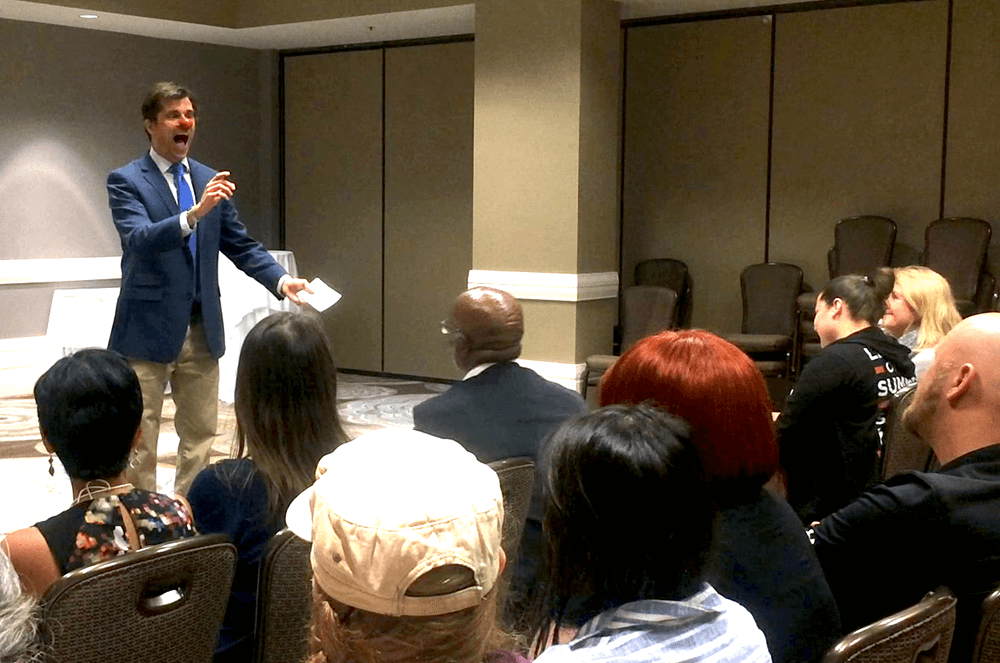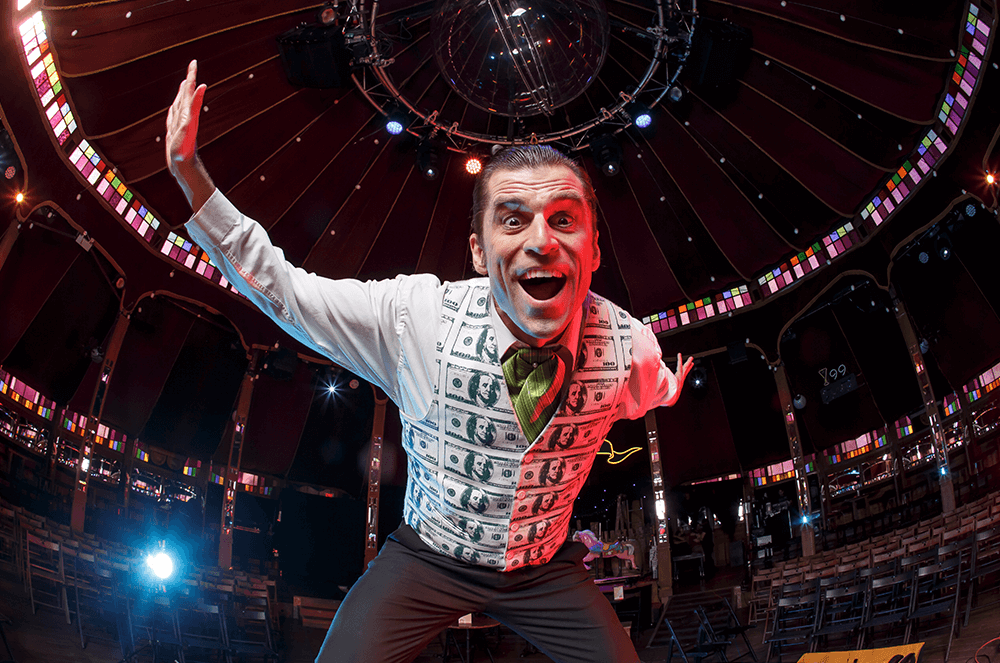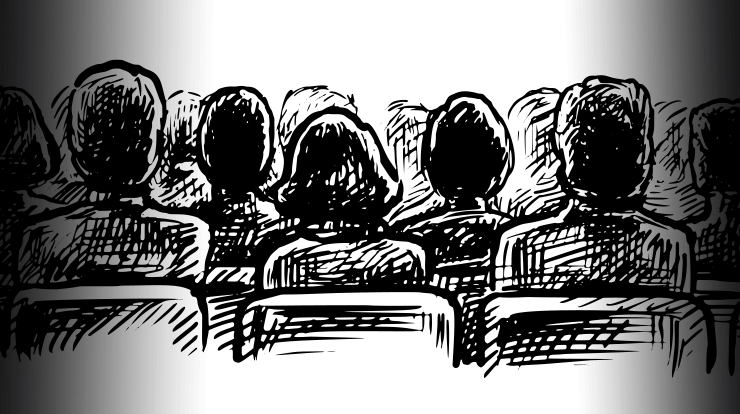
Sweat streamed down my face as I desperately tried to elicit laughs from the stone-faced students and instructor in my Intro to Clown class. I was attempting the terrifying exercise called “Save the Show,” where the student must enter the stage and get genuine laughs with zero preparation. Oh, and I forgot to mention, the instructor had also directed the audience to offer absolutely no “pity” laughter.
After what seemed like hours of frantic effort and cringey silence, I surrendered. I threw up my hands and honestly asked the audience, “What do you want?!” To my surprise, the entire room suddenly erupted in laughter! Relief swept over me as I realized that authentic engagement with my audience was far more compelling than my best comedic efforts. As time went on, I continued to utilize this power of engagement to connect with audiences while in the performance art troupe Blue Man Group and as a professional touring clown. Now I use it as a trainer, coach, and speaker for Fortune 500 companies around the world.
In this Toastmasters Podcast episode, learn how to tap into your clown presence with professional speaker and performer Don Colliver.
Pioneering clown teacher and French stage actor Jacques Lecoq explained that clowning actually requires authentic engagement with the audience to even exist. This engagement is a two-way conversation as the audience and clown discover the twists and turns of the performance together. As a Toastmaster, you too can use this power of engagement to establish a dynamic, unforgettable connection with your audience. Here are four engagement techniques to add these back-and-forth patterns to your presentations.
1 Make it about them.
My solo clown acts often occur in a pitch-black theater where I’m illuminated by a single spotlight. Sometimes, during a quiet part of my act, an audience member will sneeze out in the darkness. If I simply pause and playfully look toward the sneeze, I always generate a favorable giggle not only from the sneezer, but also from the entire audience. Acknowledging just one single audience member can actually engage an entire audience! But remember to always acknowledge your audience members in a positive way rather than calling them out negatively, which can turn them against you.
Your Turn
In your next speech, keep an eye out for nonverbal responses from your audience, like someone nodding affirmatively during one of your points. To add some engagement, pause and emphatically state, “Yes! I saw that nod! This person knows what I’m talking about!” followed by an exaggerated nod in response. Chances are you’ll receive a smile not only from the nodding audience member but also from the rest of the audience. Engagement achieved!
2 Make it in the present.
Asking the audience to engage in some kind of physical activity is a common technique in successful clown acts for good reason—it works! Having people interact with their immediate environment reminds them that your presentation is not a recording. Activities like sharing information with neighbors, switching seats, or passing around a prop reminds your audience that you’re all together in the moment. Encouraging them to engage with their other senses besides just hearing and seeing will keep them focused on your message.
Your Turn
Keeping your audience in the present is especially effective as an engagement technique during virtual presentations. Next time you find yourself delivering a speech online, consider adding some audience engagement that encourages your viewers to interact with their immediate environment. Perhaps script an audience check-in during your intro by asking them to look out of a nearby window and then type their local weather into the virtual meeting chat. Reminding your virtual audience that they are actively participating in your speech will pull them into active engagement with you and your content.
3 Make it personal.
A clown is often tempted to stop and share with the audience even when it gets them in trouble, and the audience usually can’t get enough! Personal stories are a well-known tool in effective presentations because they create engagement through vulnerability and rapport. As you tell your personal story, your audience relates to your wants, needs, and fears, and can’t wait to learn what happens next. Additionally, by using a personal story as an “aside” during your presentation, your audience will feel like you’re breaking out of your rehearsed presentation just for them, engaging them in an even more immediate way.
Your Turn
Try building an “aside” into your next speech. Stories about a time that you learned something or felt awe or wonder work particularly well in engaging an audience because they show courageous vulnerability. Use the following Setting-Problem-Decision story-launch I developed to get your audience hanging on your every word.
Setting
Vividly describe the environment you were in and the emotions you felt to transport your audience back to the moment of your story. For example, “This reminds me of a time back in 1997. It was a cold and snowy winter in Philadelphia, and I was feeling very nervous and fearful about an upcoming work presentation.”
Personal stories are a well-known tool in effective presentations because they create engagement through vulnerability and rapport.
Problem
Explain the relatable challenge that you faced and what was at stake. For example, “My boss had encouraged me to take on a quarterly presentation to our Board of Directors. My pride was at stake and my job was on the line!”
Decision
Clarify the intentional decision you made to address your problem. For example, “As I sat worrying in my apartment one night, I thought, I’ve got to do something about this. That was the exact moment I decided to join my local Toastmasters club!”
Once you’ve launched your story with the Setting-Problem-Decision framework, you will have your engaged audience in the palm of your hand.
4 Make it physical.
Prior to the start of circus shows, clowns often circulate through the big top to get the crowd energized for the upcoming extravaganza. These activities often involve having the audience mirror simple, nonverbal gestures. For example, a clown may lead a section of the audience in some kind of fun, clapping rhythm. You too can use prompting gestures to engage your audience by simply modeling a nonverbal behavior and encouraging them to mirror that behavior back, like a head nod or a hand raise.
Your Turn
At the top of your next speech, script a prompting gesture during your introduction. Describe a relatable experience while nodding your head affirmatively, encouraging your audience to mirror that nod back to you. For example, if you’re presenting a persuasive speech about using public transportation, you could say, “I think we’ll all agree that traffic can be frustrating!” as you nod your head expectantly. Your audience will probably respond by mirroring your head nod. Setting up some simple prompting gestures during your talk can be an easy way to increase engagement by encouraging your audience to mirror your gestures and agree with your statements.
There’s no need to step in front of a stone-faced clown class to start using the power of audience engagement in your presentations. Try some of these simple techniques in your next speech and you may be surprised to find yourself in a more dynamic partnership with your audience. You will stop presenting to your audience and start engaging with your audience!
Don Colliver is a corporate trainer, trade show presenter, and bestselling author living in the San Francisco Bay Area of California. He teaches teams to communicate more effectively so they can exceed their goals. Reach him at doncolliver.com.



 Previous
Previous

 Previous Article
Previous Article


